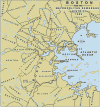Watersheds in Child Mortality: The Role of Effective Water and Sewerage Infrastructure, 1880 to 1920
- PMID: 31073249
- PMCID: PMC6502471
- DOI: 10.1086/700766
Watersheds in Child Mortality: The Role of Effective Water and Sewerage Infrastructure, 1880 to 1920
Abstract
We explore the first period of sustained decline in child mortality in the U.S. and provide estimates of the independent and combined effects of clean water and effective sewerage systems on under-five mortality. Our case is Massachusetts, 1880 to 1920, when authorities developed a sewerage and water district in the Boston area. We find the two interventions were complementary and together account for approximately one-third of the decline in log child mortality during the 41 years. Our findings are relevant to the developing world and suggest that a piecemeal approach to infrastructure investments is unlikely to significantly improve child health.
Figures





References
-
- American Society of Civil Engineers. Transactions of the American Society of Civil Engineers. 1901 Dec46
-
- Apple Rima D. Mothers and Medicine: A Social History of Infant Feeding, 1890–1950. Madison, WI: University of Wisconsin Press; 1997.
-
- Baker Moses Nelson. The Manual of American Water-Works, 1897. New York, NY: The Engineering News Publishing Co.; 1897.
-
- Beach Brian, Ferrie Joseph, Saavedra Martin, Troesken Werner. Typhoid Fever, Water Quality and Human Capital Formation. Journal of Economic History. 2016;76(1):41–75.
Grants and funding
LinkOut - more resources
Full Text Sources
